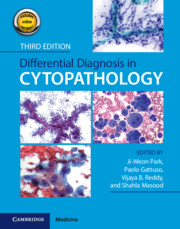Book contents
- Differential Diagnosis in Cytopathology
- Differential Diagnosis in Cytopathology
- Copyright page
- Dedication
- Contents
- Contributors
- Preface
- 1 The Pap Smear
- 2 Exfoliative Pulmonary Cytology
- 3 Body Cavity Fluids
- 4 Gastrointestinal Tract
- 5 Urinary Cytology
- 6 Cerebrospinal Fluid and Intraocular Cytology
- 7 Cytopathology of Central Nervous System
- 8 Fine-Needle Aspiration of Thyroid Gland
- 9 Parathyroid Gland, Head, and Neck
- 10 Salivary Glands
- 11 Cytopathology of the Breast
- 12 Fine-Needle Aspiration of Lymph Nodes
- 13 Fine-Needle Aspiration of Lung, Pleura, and Mediastinum
- 14 Fine-Needle Aspiration of Liver
- 15 Fine-Needle Aspiration of the Pancreas
- 16 Fine-Needle Aspiration of Soft Tissue and Bone
- 17 Fine-Needle Aspiration of the Kidney and Adrenal Gland
- 18 Cytology of the Gonads
- 19 Fine-Needle Aspiration Cytology of Tumors of Unknown Origin
- Index
- References
1 - The Pap Smear
Published online by Cambridge University Press: 05 March 2021
- Differential Diagnosis in Cytopathology
- Differential Diagnosis in Cytopathology
- Copyright page
- Dedication
- Contents
- Contributors
- Preface
- 1 The Pap Smear
- 2 Exfoliative Pulmonary Cytology
- 3 Body Cavity Fluids
- 4 Gastrointestinal Tract
- 5 Urinary Cytology
- 6 Cerebrospinal Fluid and Intraocular Cytology
- 7 Cytopathology of Central Nervous System
- 8 Fine-Needle Aspiration of Thyroid Gland
- 9 Parathyroid Gland, Head, and Neck
- 10 Salivary Glands
- 11 Cytopathology of the Breast
- 12 Fine-Needle Aspiration of Lymph Nodes
- 13 Fine-Needle Aspiration of Lung, Pleura, and Mediastinum
- 14 Fine-Needle Aspiration of Liver
- 15 Fine-Needle Aspiration of the Pancreas
- 16 Fine-Needle Aspiration of Soft Tissue and Bone
- 17 Fine-Needle Aspiration of the Kidney and Adrenal Gland
- 18 Cytology of the Gonads
- 19 Fine-Needle Aspiration Cytology of Tumors of Unknown Origin
- Index
- References
Summary
The latest guidelines for cervical cancer screening by the American Society of Colposcopy and Cervical Pathology (ASCCP) was published in 2012. The new ASCCP risk-based management consensus guidelines are under development and are scheduled for publication in 2020. According to the US Preventative Services Task Force, the most recent recommendations (which apply to individuals who have a cervix, regardless of their sexual history or HPV vaccination status; not applicable to individuals who have been diagnosed with a high-grade precancerous cervical lesion or cervical cancer, individuals with in utero exposure to diethylstilbestrol, or those who have a compromised immune system) as of August 2018 include
- Type
- Chapter
- Information
- Differential Diagnosis in Cytopathology , pp. 1 - 36Publisher: Cambridge University PressPrint publication year: 2021



